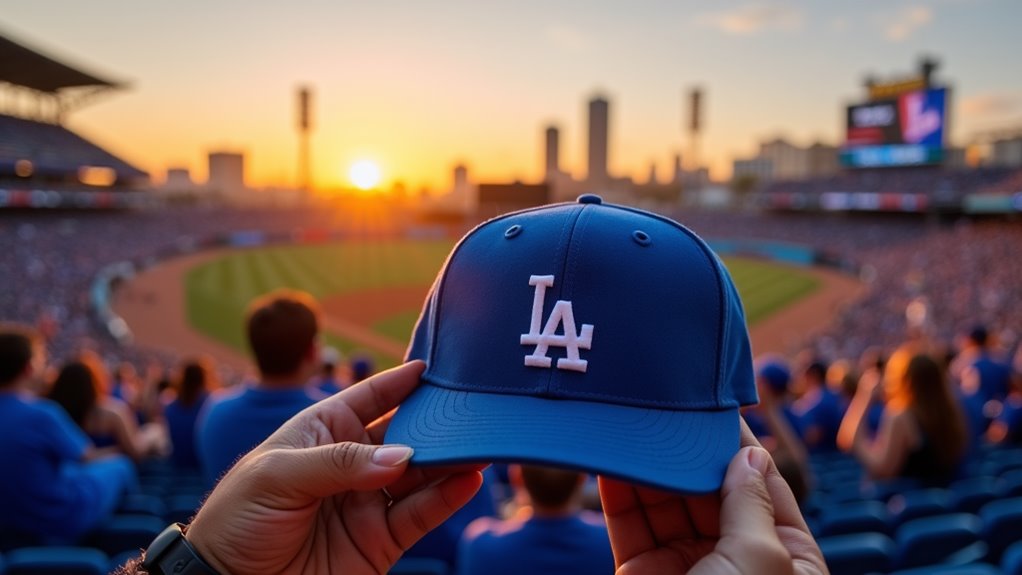Kendrick Lamar's "Dodger Blue" is a vibrant ode to Los Angeles life. The color itself isn't just about baseball; it symbolizes community pride and cultural identity. When you listen, you're hearing Lamar weave together themes of resilience and authenticity, capturing the highs and lows of L.A. living. He uses the Dodger's legacy—not just as a sports team, but as a beacon of diversity and unity. With rhythmic flow and rich metaphors, he invites you to reflect on your own connection to the city. And trust me, there's so much more to uncover behind those lyrics!
Key Takeaways
- Kendrick Lamar's references to "Dodger Blue" symbolize allegiance to Los Angeles and the shared cultural identity of its diverse residents.
- The color represents resilience and loyalty to community roots amidst the challenges faced in L.A.
- Lamar juxtaposes the glamour of Los Angeles with its underlying struggles, reflecting the complexities of ambition and survival.
- His lyrics invite multiple interpretations, exploring themes of personal growth, community pride, and the intertwining of sports culture with local narratives.
- "Dodger Blue" enhances community engagement and fan culture, fostering unity and a shared spirit among diverse ethnic groups in Los Angeles.
Dodger Symbolism in Lyrics
Dodger Symbolism in Lyrics
Kendrick Lamar's song "Dodger Blue" masterfully weaves in layers of meaning through its title and lyrics, encapsulating the essence of Los Angeles and illustrating the complex, often contradictory nature of its culture. Several key phrases, recurring themes, and symbols emerge when closely examining Lamar's lyrical content.
Key Phrases and Imagery
- "Dodger Blue": The title itself serves as a multifaceted symbol. It not only signifies allegiance to the Los Angeles Dodgers, a team deeply embedded in L.A.'s cultural landscape, but also evokes a sense of pride associated with the city. This blue hue resonates with both the Dodgers and the Crips, a prominent gang, illustrating the duality of beauty and violence that characterizes urban life in Los Angeles.
- Local High Schools: Kendrick references schools such as Gardena, Compton, Westchester, and King/Drew, underscoring his personal ties to the diverse neighborhoods of Los Angeles. This not only grounds his narrative in specific locations but also reflects a broader commentary on educational and socioeconomic disparities within the city.
- Party Scenes and Social Media: Descriptions of late-night parties and the toxicity of social media highlight the vibrant yet sometimes perilous nature of L.A. culture. This imagery suggests a constant tension between celebration and danger, illustrating how joy can coexist with adversity.
Recurring Themes, Symbols, and Metaphors
Interpretations and Ambiguity
Kendrick Lamar's lyrics often embrace ambiguity, inviting listeners to interpret them in various ways. The simultaneous references to gang culture, sports fandom, and personal history create a layered narrative that can be read through multiple lenses—whether as a reflection on personal growth, community struggles, or an expression of local pride.
For example, the "Dodger Walk" reference may signal a nod to the famous Crip Walk, merging the cultural significance of the Dodgers with the pervasive influence of gang culture. This determination to connect two disparate elements of L.A. life adds depth and complexity to his message while leaving room for interpretation regarding how these influences interact in the life of a resident.
Conclusion
In "Dodger Blue," Kendrick Lamar employs thoughtful imagery and clever symbolism to present a rich tapestry of Los Angeles's cultural landscape. Through his exploration of authenticity, resilience, and the struggle between glamour and grit, Kendrick sheds light on the dichotomy of life in L.A. His work highlights the importance of understanding the nuances within urban experiences—an invitation to embrace the complexities of identity and community within the city.
Rhythmic Patterns and Flow
Kendrick Lamar's "Dodger Blue" stands out as a masterclass in how musical qualities—tempo, rhythm, instrumentation, and vocal delivery—interact with lyrics to evoke a complex narrative that reflects the vibrant yet harsh realities of Los Angeles culture.
Tempo and Rhythm
The song features a fluid tempo that oscillates between fast-paced sections and slower, contemplative moments. This duality allows Kendrick to convey urgency in certain lyrical passages while creating space for introspection. The rhythmic repeats, such as "Walk, walk, walk, walk / Tip, toe, pivot, walk," encapsulate a sense of calculated movement, reflecting themes of strategy and intentionality often associated with steering life in a city fraught with challenges.
Instrumentation
Instrumentally, "Dodger Blue" blends heavy bass with bouncy synthesizers to create a laid-back yet engaging atmosphere. The heavy bass serves as the foundation of the track, anchoring the more vibrant synths that bounce playfully on top. This combination results in a soundscape that feels both grounded and buoyant. The instrumentation complements the lyrical content, where moments of aggression shift smoothly into more mellow vibes, reflecting the emotional highs and lows of the narrative.
Vocal Delivery
Kendrick's vocal delivery is another key element that enhances the song's meaning. His dynamic flow varies in speed and intensity, adapting to the theme of each section. For example, moments of heightened energy are matched with assertive lyrics, like in "When I walk in, oh yeah, bring that / It's unanimous, how I pop shit." Conversely, during introspective sections, his vocals become softer and more reflective, inviting the listener to engage with the deeper emotions behind the story being told.
Interaction with Lyrics
The interaction between the music and lyrics creates a profound mood that underscores the song's themes. The rhythmic patterns used in the musical composition amplify essential points within the lyrics, creating an echo that fosters a greater emphasis on Kendrick's storytelling. For instance, the strategic use of rhythmic repetition in the lyrics reinforces the themes of movement and resilience, significant aspects of steering the complexities of life in Los Angeles. Moreover, the collaborations with artists like Wallie The Sensei and Roddy Ricch enrich the song's flow and authenticity, contributing to the album's notable collaborations. Each featured artist brings a unique style that blends harmoniously with Kendrick's own signature sharpness, creating a rich tapestry of sound and perspective. The smooth shifts between verses maintain engagement and enhance the coherence of the narrative structure.
Structural Elements
The structured arrangement of "Dodger Blue" supports its overarching message. Each segment, characterized by effective shifts, contributes to a cohesive exploration of culture, strategy, and personal experience. The use of repetitive rhythms and phrases adds cohesion and reinforces the thematic elements, helping the listener to grasp the multifaceted nature of the narrative.
Cultural Significance of Dodger Blue

Cultural Significance of Dodger Blue
Dodger blue transcends its identity as merely a color associated with the Los Angeles Dodgers; it embodies cultural significance that reflects the ethos of Los Angeles and its diverse community. The vivid hue serves as an emblem of unity among fans, creating a shared identity that resonates with individuals from various backgrounds. This aspect of unity is particularly vital in a city as metropolitan and diverse as Los Angeles, where sports can bridge divides and foster connections among different ethnic and cultural groups.
Historically, the Dodgers have been pivotal in promoting inclusivity and diversity within Major League Baseball. Their roster has famously included trailblazers such as Jackie Robinson, the first African American to play in the MLB, alongside other notable players from various ethnic backgrounds, such as Sandy Koufax and Fernando Valenzuela. These figures aren't only celebrated for their athletic prowess but also for the cultural narratives they represent, contributing to the Dodgers' legacy as a team that symbolizes progress and acceptance. Additionally, the Dodgers' commitment to fostering a welcoming environment for women in sports has further reinforced their role as a leader in promoting diversity. Dodger blue itself evokes feelings of excitement that align with this spirit of progress and inclusivity.
The phenomenon of "Dodger Blue" extends beyond the team itself, influencing community gatherings and fan engagement. Groups like Pantone 294, supporters who travel to games to show their allegiance, demonstrate how the color has galvanized a collective passion for the team, reinforcing the idea that sports can unify communities. Dodger blue rallies people under a singular banner, fostering a spirit of camaraderie that's palpable in the stands and beyond.
Moreover, the color plays a role in the fabric of Los Angeles' identity. It's woven into the city's cultural tapestry, representing both the joy and the struggles of its residents. The Dodgers are seen not just as a sports team but as a source of hope and inspiration, particularly for the youth in the area. The action of donning Dodger blue becomes a statement of support for local talent and a celebration of shared aspirations.
In addition, the Dodgers' commitment to inclusivity—seen through initiatives aimed at welcoming women as coaches and players—underscores the relevance of Dodger blue in contemporary society. This forward-thinking approach aligns with the broader movement towards progressive representation in sports and sends a powerful message about the importance of diversity and inclusion.
Final Thoughts on Dodgers
It seems there's been a misunderstanding.
The provided facts focus on the history of the Los Angeles Dodgers, while the directions request a summary and analysis related to Kendrick Lamar's song lyrics. Additionally, the Dodgers' impact on baseball as a pioneer in breaking the color barrier resonates with the themes of struggle and triumph often found in Kendrick Lamar's music. The team's legacy includes a commitment to community engagement, which aligns with Lamar's focus on social issues in his work. Please clarify if you'd like a summary of the Dodgers' history or if there's a specific Kendrick Lamar song you'd like analyzed.


Leave a Reply